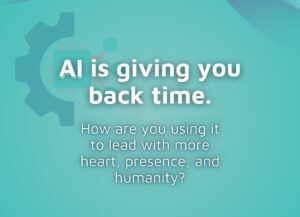The AI Advantage: How Smart Leaders Are Reinvesting Time in Human Connection
There’s no denying it; AI is transforming the workplace.
From automating administrative tasks to streamlining data analysis and handling basic customer queries, it’s giving leaders something far more valuable than information: time.
AI has its place, and as a thought leader, IP creator and writer I will never use to generate my content, but I am seeing the value it adds doing the mundane tasks that enables me to do the great things opposed to the good things.
Working with leaders and teams for over 2 decades the challenge of being time poor is one of the constant pressures’ leaders face and a challenge that involves self-management to rectify.
Only last week I was working with a CEO around increasing his productivity and connection with his team. During the session I asked him “What AI are you using and how much time is it saving you? He agreed that he was saving time, up to 5 hours per week and when I asked him what he was doing in that time, he replied “Catching up on emails, focusing on sales and the usual, putting out fires.”
It natural to fill time in a reactive way but what are the best leaders doing with that time?

They’re not simply ticking more off their to-do lists. They’re choosing to reinvest it where it matters most, is the human touch. Because while AI can increase efficiency, it can’t replace empathy, presence, or the deep connection that inspires and engages teams.
We need to bring back the human touch and direct our energy, heart, connection and frequency to people not computers.Many workplaces are experiencing a disconnection crisis that AI is contributing to.
What I am seeing across the multiple industries we work in is the following:
Soft skills are fading: With AI doing the “talking,” empathy, influence, and conflict resolution are taking a back seat.Shallow communication: Zoom calls, Slack messages, and emails have replaced deeper, in-person dialogue. Efficiency is up, but trust and collaboration are down.Information overload: With data coming at us from all angles, it’s harder to focus, stay engaged, and think critically.Fewer human interactions: Automated workflows and chatbots are replacing conversation, making people feel like cogs in a machine.Emotional disconnect: AI lacks emotional intelligence and without intentional efforts, so can our teams.Creativity and critical thinking on the decline: AI’s instant solutions may reduce innovation, as teams defer to machines instead of exploring their own ideas.Burnout and fatigue: Constant digital noise leads to stress, mental fatigue, and a sense of overwhelm.Loss of presence: Leaders struggle to truly listen amid distractions, impacting psychological safety.Culture erosion: Remote and AI-driven communication weakens the sense of belonging and team identity.Over-reliance on AI for decisions: Critical thinking suffers when people stop questioning and start deferring.But here’s the good news: forward-thinking leaders are recognising these risks and using the time AI saves to bring back the human touch.

I believe AI has created the space to bring back what fast-paced business and digital overload have pushed to the side and that is genuine human connection.
We are doing a lot of work with our clients on this, so I’ll share some ways Limitless Leaders are making this shift and maximising the time AI gives us back.
7 Ways to Bring Back the Human TouchBe Present, Not Just Available
Being available on Slack or email isn’t the same as being truly present. Take time for face-to-face or voice-to-voice conversations and minimise distractions. Set boundaries with your technology to create intentional, human moments. Whether it’s a five-minute phone call or a longer check-in, being fully there makes people feel seen and heard.
Master Verbal Communication
Verbal communication is where connection lives, in tone, energy, and responsiveness but written communication is often prioritised in modern workplaces. Leaders who invest in sharpening their verbal skills are better able to influence, inspire, and connect.
Ask Better Questions
AI can provide answers, but I believe leaders need to ask the questions that matter. Practice curiosity. Ask questions that go beyond performance metrics, like: What’s feeling heavy for you right now? What’s one thing you wish we talked about more as a team? What do you need help with? What lights you up? These can open space for honesty and connection.
Create Human-Centred Rituals
We all know that AI can streamline processes, but it can’t create belonging. Leaders can establish rituals that build team culture: eating together, weekly gratitude rounds, open mic sessions for new ideas, or monthly ‘Win Wednesday check-ins. Sharing our lesson we can adopt a Gift Mindset and share best practice as well as challenges. These don’t just foster connection they create psychological safety and a culture of care.
Lead with Emotional Intelligence
Efficiency doesn’t equal empathy. Leaders are choosing to re-centre their attention on people not just performance. That means recognising when a teammate is struggling, validating emotions, and cultivating environments where people feel safe to speak up.
Building your EQ takes time, but it starts with one key habit: be curious, not just responsive. Ask, “What else is going on here? “and then listen. Ramping up EQ in a world of AI is non-negotiable.
Be Present and Focused
Notifications, multitasking, and AI tools can make leaders feel like they’re always on but rarely present. But the best leaders are learning to pause. Give yourself permission to pause and just be. Reclaiming space to think, reflect, and engage fully.
Try blocking 15–20 minutes each day to be offline but available. Implement time for walking meetings, impromptu chats, or simply thinking deeply about challenges without screens.
Rebuild Culture Through Connection Rituals
Workplace culture can’t be outsourced to AI. Culture is about the people and is built through shared moments, rituals, values in action, and human storytelling. Limitless leaders are reintroducing simple, high-impact rituals such as weekly gratitude rounds, storytelling sessions, team wins celebrations.
These are only micro-moments, but they build impact resulting in stronger relationships, shared meaning, and a more connected workplace.
AI has the power to streamline, support, and scale but I believe it can’t replace what makes teams thrive: empathy, presence, trust, and connection.
Limitless leaders aren’t choosing between AI and humanity.
They’re using AI to make space for more humanity.
They’re asking: “What do I want to do with the time I’ve reclaimed?” And the answer, increasingly, is connect more deeply, lead more meaningfully, and communicate more powerfully.
Let’s bring the human touch back, one conversation, one moment, one decision at a time.
I’d love to hear your thoughts on this.
Lead to be limitless,




